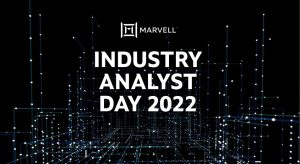16
Dec
Marvell Industry Analyst Day 2022 – Doubling down on the Data Infrastructure market
 Marvell Technologies held its yearly industry analyst day on Dec 6th, 2022, at its headquarters in Santa Clara, California. The overwhelming message from the event was how its relentless focus on the Data Infrastructure market across mainly four segments— Data Center, Carrier Infrastructure, Automotive, and Enterprise Networking—is paying off.
Marvell Technologies held its yearly industry analyst day on Dec 6th, 2022, at its headquarters in Santa Clara, California. The overwhelming message from the event was how its relentless focus on the Data Infrastructure market across mainly four segments— Data Center, Carrier Infrastructure, Automotive, and Enterprise Networking—is paying off.
All the speakers, including the COO, President, CTO, Chief Development Officer, all the business heads, and the breakout session leads, drove this message home with good proof points. Many guest speakers from present there physically or through videos endorsed Marvell’s technology and the collaboration between the companies.
Here are some of the key points from the presentations:
Data Infrastructure company
-
88% of Q3 FY22 revenues from data infrastructure business (12% from the consumer)
-
Serving the majority of the top customers in all the four target segments
-
Revenue doubling between 2021 and 2023e (~$3B to ~$6B)
Silicon Strategy
-
Technology leadership and platform approach – compute + packaging + interconnect
-
Changed from fast follower to technology leader (E.g., 5nm and 3nm nodes)
-
Product leadership – compute, electro-optics, networking, security, storage
-
Flexible business model – merchant, custom, hybrid
Data Processing Unit (DPU)
-
Advantages of CPU-centric (E.g., Intel) vs. power optimized compute+ specialized accelerators + interconnects
-
Industry’s first 5nm DPU, shipping across segments
-
Strong endorsement from Nokia and Vodafone
Switching, PHY & Optical Interconnects
-
Teralynx switching architecture leadership
-
Interconnect speeds in data centers are increasing rapidly (up to 1.6 Tbps)
-
Enabler for distributed data centers
-
Leadership in PHY (10G, 200G, 400G, 800G, 5nm onboard 1.6T)
-
Complete data center networking platform
-
Endorsement from Ruckus Networks / CommScope
Storage and Memory
-
Leading in HDD/SSD controllers
-
Growth sectors – preamp, accelerators, & CXL solutions
-
Endorsements from Microsoft, Micron, and Toshiba
Automotive
-
Zonal architecture replacing point-to-point connection, domain consolidation
-
Strong Ethernet adoption
-
Automotive semiconductor content is increasing (Up to $125 per car)
Custom Silicon Business
-
> 25% of SAM
-
Leveraging all of Marvell’s technologies
-
Unique business model, unmatched in the industry
Challenge of AI training platforms
-
AI to surpass human intelligence in 2045
-
Scalable, fully disaggregated data center, enabled by integrated optically connected computing, is the only solution
-
Marvell best positioned for this future

0 comments